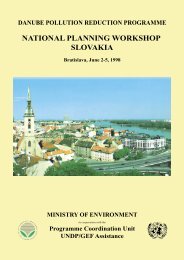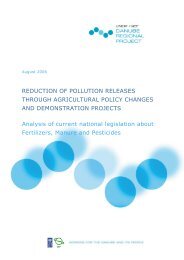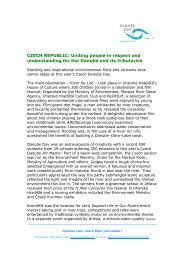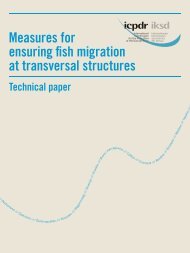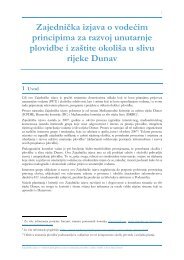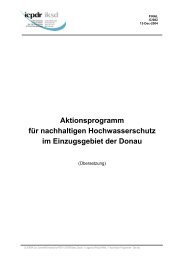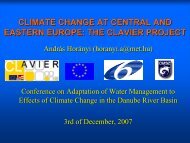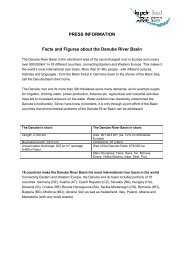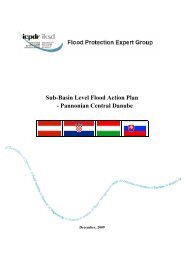Technical Reports Parts C,D - ICPDR
Technical Reports Parts C,D - ICPDR
Technical Reports Parts C,D - ICPDR
You also want an ePaper? Increase the reach of your titles
YUMPU automatically turns print PDFs into web optimized ePapers that Google loves.
<strong>Technical</strong> <strong>Reports</strong> – Part D: Water Environmental Engineering 145<br />
The construction of new or enlargement of operational cattle-breeding complexes and farms, of<br />
facilities to store fertilizers and pesticides, the formation of pastures for animals, the<br />
commissioning of parking areas for cars and agricultural conveyance means are not allowed in the<br />
water protective zones. The conduct of activity related to the regulation of flow the construction of<br />
water intake facilities is permitted only following a specific concentration process, i.e. concurrence<br />
by the Ministry for Fishery and the State Committee of Ukraine for water management.<br />
Waterside streaks should be obligatorily planted by trees and bushes being natural regulators of<br />
flow. Waterside planting prevents the progress of erosion processes and captures pollutants well.<br />
Within limits of water protective zones and especially of the shore sides (streaks) one should not<br />
plough and pasture animals. If the water protective area belongs to a territory with an average<br />
economic activity then the watersides must be a territory, where any type of commercial activity is<br />
strictly regulated.<br />
Within limits of water protective zones of rivers, lakes, water reservoirs and artificial lakes a<br />
complex of administrative territorial forest reclamation, antierrosive, hydroengineering and other<br />
arrangements aimed at upgrading the sanitary-hygienic and environmental state of both a water<br />
body itself and its waterside, at enhancing the quality of water resources and preserving selfcleaning<br />
and recovery functions of water sources should be implemented. Regretfully, a<br />
considerable part of rivers, lakes, and other bodies of water have no reliable water protective zones<br />
in accordance with science-based recommendations; on the country, even where such zones are<br />
available, the requirements regarding control sand limitations of intensive agricultural activities are<br />
not always strictly followed, the required arrangements to decrease the migration of pollutants to<br />
bodies of water are not made in full scope. This regards specifically small and medium rivers. By<br />
withdrawing water and polluting these rivers, society caused irreversible damages to main<br />
waterways since performance of small and medium ones.<br />
The limits of field often approach the banks of rivers, lakes, water reservoirs, which is the principal<br />
cause for their silting. A big deal of agricultural utilities, farms etc. is located too close to water in<br />
some places of the Ukrainian part of the Danube basin. The same is characteristic to cattle-breeding<br />
farms and complexes. This causes much damages to water resources since the overloaded out-ofdate,<br />
and in some cases even primitive muck (manure) storage areas belonging to farms and<br />
complexes, make poisonous leaks flow to rivers and lakes. The issue of introducing clean cattlebreeding<br />
complexes and farms has been successfully resolved neither by science, nor by practice.<br />
A considerable number of agricultural enterprises and utilities does not comply with the relevant<br />
environmental requirements while conducting commercial activities in the water protective zones,<br />
does not pay due attention to plant and maintain trees and other facilities, which are located within<br />
limits of the water protective zones. As a result the polluted waste of agricultural origin enters the<br />
hydrological net with no obstacles.<br />
Thus, the listed below arrangement foster drastic improvements of water resources under intensive<br />
agricultural activity:<br />
<br />
<br />
<br />
<br />
<br />
introduction of and compliance with the norms and techniques to bring in fertilizers with<br />
due respect to soil, climate and geographical peculiarity of each crop-growing region, to<br />
the agricultural hardware available etc.;<br />
bringing in of fertilizers mainly in granulated form as well as locally;<br />
implementation of strict control over compliance with the rules to utilize fertilizers and<br />
other chemicals at any agricultural utility;<br />
the prevention of storing fertilizers and other chemicals for a long period of time with no<br />
utilization in cultivated fields and land;<br />
the arrangement of correspondingly equipped sites for intermediate stockade of fertilizers<br />
and pesticides in fields in order to prevent their inadvertent ingress into the environment;



